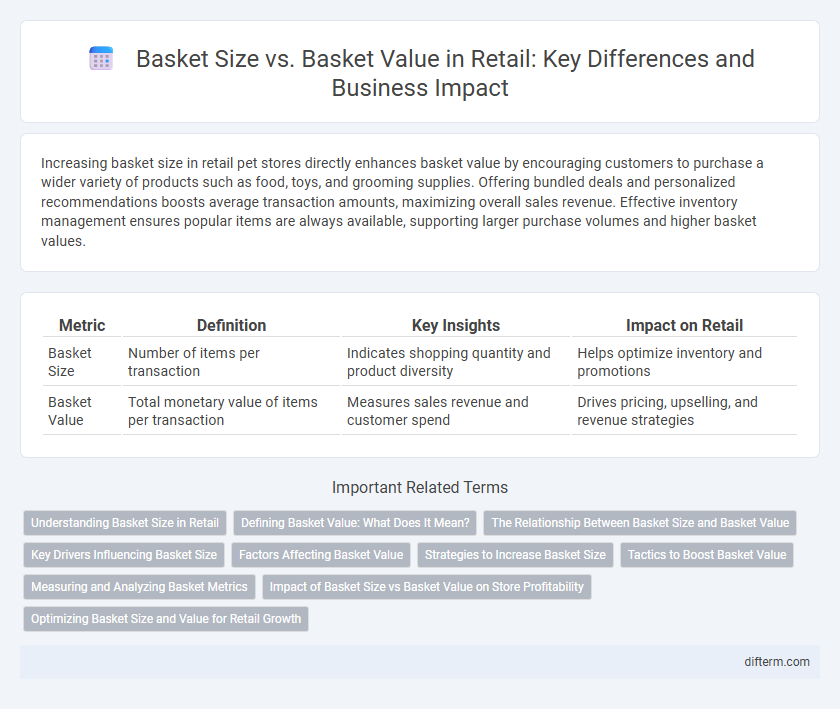Increasing basket size in retail pet stores directly enhances basket value by encouraging customers to purchase a wider variety of products such as food, toys, and grooming supplies. Offering bundled deals and personalized recommendations boosts average transaction amounts, maximizing overall sales revenue. Effective inventory management ensures popular items are always available, supporting larger purchase volumes and higher basket values.
Table of Comparison
| Metric | Definition | Key Insights | Impact on Retail |
|---|---|---|---|
| Basket Size | Number of items per transaction | Indicates shopping quantity and product diversity | Helps optimize inventory and promotions |
| Basket Value | Total monetary value of items per transaction | Measures sales revenue and customer spend | Drives pricing, upselling, and revenue strategies |
Understanding Basket Size in Retail
Basket size in retail refers to the total number of items a customer purchases during a single transaction, reflecting consumer buying behavior and purchasing frequency. Monitoring basket size helps retailers optimize inventory management and tailor marketing strategies to increase customer engagement and repeat visits. Larger basket sizes often indicate higher shopper satisfaction, though they do not always correlate directly with basket value, which measures the total monetary amount spent.
Defining Basket Value: What Does It Mean?
Basket value refers to the total monetary amount a customer spends in a single transaction, reflecting the overall revenue generated per purchase. It encompasses the price of all items combined in the shopping basket, influenced by product pricing, discounts, and promotions. Understanding basket value helps retailers optimize pricing strategies, improve inventory management, and enhance customer experience by targeting higher spend per visit.
The Relationship Between Basket Size and Basket Value
Basket size, the number of items purchased in a single transaction, directly influences basket value, the total monetary amount spent by the customer. Larger basket sizes often lead to higher basket values due to increased product quantity and potential cross-selling opportunities. Retailers analyze this relationship to optimize pricing strategies, promote product bundling, and enhance customer experience, driving overall sales performance.
Key Drivers Influencing Basket Size
Basket size is primarily influenced by factors such as product variety, promotional strategies, and in-store merchandising, which encourage customers to add more items per transaction. Consumer behavior insights reveal that personalized recommendations and loyalty programs significantly boost basket size by increasing shopper engagement and perceived value. Efficient store layout and availability of complementary products also drive larger basket sizes by facilitating easier discovery and impulse buying.
Factors Affecting Basket Value
Basket value is influenced by factors such as product assortment, pricing strategies, and promotional offers, which drive customer spending beyond mere basket size. Customer demographics and purchasing behavior also impact basket value, with loyal shoppers often opting for higher-value items or multiple premium products. Inventory availability and seasonal trends further affect the overall basket value by shaping consumer demand and purchase patterns.
Strategies to Increase Basket Size
Increasing basket size in retail involves encouraging customers to add more items per transaction through targeted upselling and cross-selling techniques. Implementing personalized product recommendations based on purchase history enhances the likelihood of additional item purchases, boosting overall basket size. Optimizing store layout and promotional placements also stimulates impulse buying, effectively expanding basket size and driving higher sales volume.
Tactics to Boost Basket Value
Increasing basket value in retail requires targeted upselling by recommending complementary products that align with customer preferences. Implementing dynamic pricing strategies and limited-time offers encourages shoppers to add higher-margin items, enhancing overall transaction worth. Utilizing loyalty programs and personalized promotions can effectively increase average spend per visit by incentivizing larger purchases.
Measuring and Analyzing Basket Metrics
Measuring basket size involves counting the number of items purchased per transaction, while basket value quantifies the total monetary amount spent by customers. Analyzing these metrics helps retailers identify purchasing patterns, optimize pricing strategies, and tailor promotions to increase overall sales revenue. Advanced data analytics tools enable precise tracking of basket size and value changes, improving inventory management and enhancing customer experience.
Impact of Basket Size vs Basket Value on Store Profitability
Increasing basket size by encouraging customers to add more items per transaction directly boosts overall sales volume, while elevating basket value through upselling higher-priced products enhances profit margins. Stores that optimize both basket size and value benefit from improved inventory turnover rates and greater revenue per customer, leading to higher store profitability. Effective merchandising and personalized promotions drive these metrics, ultimately maximizing operational efficiency and financial performance in retail environments.
Optimizing Basket Size and Value for Retail Growth
Optimizing basket size and basket value is crucial for retail growth by increasing the number of items purchased per transaction while maximizing the total spend. Effective strategies include targeted promotions, personalized recommendations, and strategic product placement to encourage upselling and cross-selling. Analyzing customer purchase behavior and leveraging data-driven insights helps retailers boost average transaction values and enhance overall profitability.
Basket Size vs Basket Value Infographic

 difterm.com
difterm.com